Us Nuclear Regulatory Commission
-
- Chesapeake Section Members Visit Naval Academy —Paper On Floating Nuclear Power Plants Presented Maritime Reporter, Jul 1978 #42
The April meeting of the Chesapeake Section of The Society of Naval Architects and Marine Engineers included a tour of the United States Naval Academy at Annapolis, Md., and a technical session at which the "External Effects Considerations in the Design of Floating Nuclear Power Plants" were presented by George G. Amir and James L. Simmons.
The tour of the Academy was organized by the faculty for Society members and their families, and included stimulating technical presentations as well as an entertaining seakeeping demonstration.
The highlight of the tour was an explanation of the automated features of the Academy's new towing tank which has been in operation less than one year.
The subsequent technical presentation covered design criteria development and implementation for floating nuclear power plants subjected to possibly damaging external effects. Capt. Robert K.
Reed served as moderator for the session. Captain Reed is presently director of Ship Programs in the Office of Assistant Secretary of the Navy (Manpower, Reserve Affairs and Logistics). He formerly held the positions of Supervisor of Shipbuilding at Groton, Conn., Planning Officer at the Puget Sound Naval Shipyard, and Project Manager for the SSN 637-Class submarine. The authors of the technical paper are both members of Designers and Planners, Inc. in Washington, D.C.
Mr. Amir, general manager of the Washington office, was educated at the New York Institute of Technology, and Northeastern University. His varied career includes service as a merchant marine officer, design of power plant equipment for Ship Systems, where he was responsible for im- plementing shock design, analysis and test efforts to ensure that the DD-963-Class of destroyers and the LHA-l-Class of Amphibious Assault Ships meet the stringent U.S. Navy survivability requirements.
A former member of the U.S. Nuclear Regulatory Commission, Mr. Amir has worked toward improving the structural safety of land-based and floating nuclear power plants.
Mr. Simmons attended the Massachusetts Institute of Technology, and Columbia University prior to receiving his commission in the U.S. Navy and his designation as an Engineering Duty Officer in 1957. Following various engineering duty assignments, he was ordered to the U.S. Naval Postgraduate School from which he received an M.S. degree in 1966. Subsequently, he had duty tours at the Portsmouth Naval Shipyard, in the USS Cadmus at the Naval Ship Engineering Center, and at the Headquarters of the Military Sealift Command. He is currently director, naval architecture, for the Washington, D.C., office of Designers and Planners, Inc.
In their presentation, the authors discussed design criteria and their implementation in the floating nuclear power plant (FNPP) when subjected to external effects. The FNPP idea was proposed in the late 1960s because of site flexibility, immediate abundance of water, possible decoupling from seismic shock, and because the concept lends itself to a high level of standardization.
The current concept is in the final detailed design stages, and manufacturing facilities are nearly complete. The FNPP, when located offshore, must be protected by a breakwater to which it is permanently fastened by a mooring system. The major effects considered in the design of the FNPP are due to natural phenomena, accidents, and man-made adverse conditions. Tornadoes, hurricanes, tsunami waves and shipping accidents are considered for both safe operation and safe shutdown of the plant. Earthquakes, sub-marine slides, underwater currents and storms are considered for the breakwater design as well as for their effect on the FNPP through the mooring system. The above conditions are investigated by model test and analysis of the seabed-fluid-structure interaction. Accident conditions such as ship collisions with the breakwater, shipping accidents resulting in explosions (air blast), and aircraft crash may be examined by statistical and probability methods and by structural testing and analysis. The authors concluded that overall floating nuclear power plant safe design is only achieved by adhering to strict design c r i t e r i a and by verification of the design by analysis, scale model, and limited prototype testing.
-
- Energy Research In The Oceans Maritime Reporter, May 1977 #12
Society of Civil Engineers (ASCE), Institute of Electrical and Electronic Engineers (IEEE) and Marine Technology Society (MTS). The papers and discussions will cover current research in such diverse areas as development in marine transportation (naval architecture and machinery), offshore platforms
-
 )
March 2024 - Marine Technology Reporter page: 48
)
March 2024 - Marine Technology Reporter page: 48. . .Birns, Inc. . . . . . . . . . . . . . . . . . . . . . . . . . . .www.birns.com . . . . . . . . . . . . . . . . . . . . . . . . . . . . . . .Please visit us online 19 . . . . .Blueprint Subsea . . . . . . . . . . . . . . . . . . . .www.blueprintsubsea.com . . . . . . . . . . . . . . . . . . . . . .+44 (0)
-
 )
March 2024 - Marine Technology Reporter page: 44
)
March 2024 - Marine Technology Reporter page: 44. Scandinavia (BUVI) to join its international sales team. Image courtesy Unique Group Sealing the deal(s) @ Oi ‘24 mating the object identi? cation process using the SAS Target in a single work? ow. The sensor’s 360-degree scanner and Assistant. The application runs in the background, leaving us- high collection
-
 )
March 2024 - Marine Technology Reporter page: 33
)
March 2024 - Marine Technology Reporter page: 33regulated industry in the world.” How- ever, commercial success depends on many factors, not least a predictable OPEX. Over the past four years, SMD has worked with Oil States Industries to calculate cost per tonne ? gures for prospective customers. Patania II uses jet water pumps to Oil States’
-
 )
March 2024 - Marine Technology Reporter page: 32
)
March 2024 - Marine Technology Reporter page: 32- the Pentagon is expected to deliver an ac- light plastic tracks and buoyant syntactic foam. The collec- tion plan on nodules by March 2024. tion vehicle uses sonar to identify the position of the nodules UK-based Soil Machine Dynamics (SMD) designed, devel- and has attained collection ef? ciency rates
-
 )
March 2024 - Marine Technology Reporter page: 27
)
March 2024 - Marine Technology Reporter page: 27SEA-KIT USV Maxlimer returning from HT-HH caldera in Tonga. © SEA-KIT International data and further assess ecosystem recov- ery. What is known, noted Caplan-Auer- bach, is that the impact of submarine vol- canoes on humans is rare. “The HT-HH eruption was a tragedy, but it was very unusual. It let us
-
 )
March 2024 - Marine Technology Reporter page: 25
)
March 2024 - Marine Technology Reporter page: 25mobilized away still had abundant life, including the Tonga Eruption Seabed Mapping Even before the recent HT-HH erup- corals, sponges, star? sh and mussels. Project (TESMaP) to understand the ex- tion, subsea technology helped scien- This indicated the resilience of certain tent of impact and inform
-
 )
March 2024 - Marine Technology Reporter page: 9
)
March 2024 - Marine Technology Reporter page: 9from marinas along the western coast. The exact number of lizing laser detection systems can detect mines just below the mines, as well as their locations, remains largely a mystery, surface, even those hiding in murky water. The Airborne Laser although reports suggest that over three hundred have been
-
 )
March 2024 - Marine Technology Reporter page: 6
)
March 2024 - Marine Technology Reporter page: 6(NOAA), and hai Ocean University in 2018. He proposed making thick wall Oceanographer of the Navy. He has a bachelor’s degree from glass spheres to Nautilus Marine Service/Vitrovex (Germany) the U.S. Naval Academy, and master and doctoral degrees from that opened the hadal depths to routine exploration
-
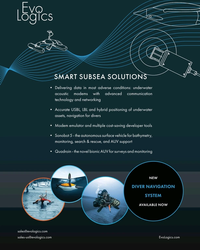 )
March 2024 - Marine Technology Reporter page: 2nd Cover
)
March 2024 - Marine Technology Reporter page: 2nd CoverSMART SUBSEA SOLUTIONS • Delivering data in most adverse conditions: underwater acoustic modems with advanced communication technology and networking • Accurate USBL, LBL and hybrid positioning of underwater assets, navigation for divers • Modem emulator and multiple cost-saving developer tools • Sonobot
-
 )
April 2024 - Maritime Reporter and Engineering News page: 48
)
April 2024 - Maritime Reporter and Engineering News page: 48& CHAINS MILITARY SONAR SYSTEMS tel:+44 (0) 1752 723330, [email protected] , www.siliconsensing.com Anchor Marine & Supply, INC., 6545 Lindbergh Houston, Massa Products Corporation, 280 Lincoln Street, SONAR TRANSDUCERS Texas 77087 , tel:(713) 644-1183, fax:(713) 644-1185, Hingham, MA 02043-1796
-
 )
April 2024 - Maritime Reporter and Engineering News page: 43
)
April 2024 - Maritime Reporter and Engineering News page: 43“The industry is an ecosystem which includes owners, managers, mariners, shipyards, equipment makers, designers, research institutes and class societies: all of them are crucial,” – Eero Lehtovaara, Head of Regulatory & Public Affairs, ABB Marine & Ports All images courtesy ABB Marine and Ports provi
-
 )
April 2024 - Maritime Reporter and Engineering News page: 42
)
April 2024 - Maritime Reporter and Engineering News page: 42OPINION: The Final Word Seeing the Ship as a System Shipping must engage with the decarbonization realities that lie ahead by changing the way it crafts maritime legislation to re? ect its place in the interconnected, interdependent world economy, said Eero Lehtovaara, ABB Marine & Ports. ABB Marine &
-
 )
April 2024 - Maritime Reporter and Engineering News page: 41
)
April 2024 - Maritime Reporter and Engineering News page: 41Nautel provides innovative, industry-leading solutions speci? cally designed for use in harsh maritime environments: • GMDSS/NAVTEX/NAVDAT coastal surveillance and transmission systems • Offshore NDB non-directional radio beacon systems for oil platform, support vessel & wind farm applications
-
 )
April 2024 - Maritime Reporter and Engineering News page: 38
)
April 2024 - Maritime Reporter and Engineering News page: 38operational autonomy of the BP re? nery, two miles from the Port of Castellón in Spain. up to eight hours, providing an ef? cient and non-polluting solu- Using its electric line handling tug Castalia, Consulmar towed tion for mooring operations. In addition to mooring, the mul- the steel mooring lines from
-
 )
April 2024 - Maritime Reporter and Engineering News page: 35
)
April 2024 - Maritime Reporter and Engineering News page: 35. FORCE Technology’s upcoming DEN-Mark2 math- lock around 50-80 times a day. It has ematical model release for its augmented reality SimFlex4 tug W changed us. Half the people surveyed and ship simulator will offer unprecedented model accuracy in a 2022 King’s College London study said that they feel like
-
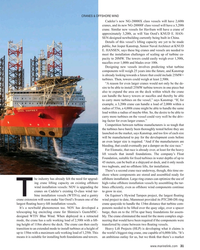 )
April 2024 - Maritime Reporter and Engineering News page: 31
)
April 2024 - Maritime Reporter and Engineering News page: 31and thereby be able to carry more turbines on the vessel,” says Kanstrup. “If, for example, a 3,200t crane can handle a load of 2,000t within a radius of 55m, a 4,000t crane might be able to handle the same load within a radius of maybe 68m. So, the desire to be able to carry more turbines on the
-
 )
April 2024 - Maritime Reporter and Engineering News page: 29
)
April 2024 - Maritime Reporter and Engineering News page: 29. Navy photo by Bill Mesta/released U.S. Navy photo by Ryan Carter Rear Adm. Philip Sobeck, Commander, United States Navy’s Military Sealift Command, visits USNS Patuxent (T-AO 201) for a tour of the ship at Naval Station Norfolk, Va., November 20, 2023. ENDLESS SUPPLY OF MARINE HARDWARE ! &"$)$?""?!!&"$l •
-
 )
April 2024 - Maritime Reporter and Engineering News page: 28
)
April 2024 - Maritime Reporter and Engineering News page: 28for the Mis- sile Defense Agency, and it travels with its support ship, the MV Hercules. For our Service Support ships, we have the two hospital ships, USNS Mer- cy and Comfort; two rescue and salvage ships; two submarine tenders; and the Sixth Fleet ? agship, USS Mount Whit- ney, that has a combined
-
 )
April 2024 - Maritime Reporter and Engineering News page: 27
)
April 2024 - Maritime Reporter and Engineering News page: 27RADM PHILIP SOBECK, MILITARY SEALIFT COMMAND With COVID, we had to make some hard choices for our Do your CIVMARs have upward mobility? mariners because we couldn’t rotate. Many of our mariners The Navy has Sailors who become “Mustangs,” and work found other employment, and were able to use their skills
-
 )
April 2024 - Maritime Reporter and Engineering News page: 26
)
April 2024 - Maritime Reporter and Engineering News page: 26replaced.” Rear Adm. Philip Sobeck, Commander, United States Navy’s Military Sealift Command Military Sealift Command’s expeditionary fast transport ship USNS Burlington (T-EPF 10) pulls into Joint Expeditionary Base Little Creek-Fort Story, Feb. 14. USNS Burlington is the U.S. Navy’s newest expeditionary
-
 )
April 2024 - Maritime Reporter and Engineering News page: 25
)
April 2024 - Maritime Reporter and Engineering News page: 25RADM PHILIP SOBECK, MILITARY SEALIFT COMMAND Photo by Brian Suriani USN Military Sealift Command From a global supply chain perspective, What makes MSC so vital to the we’ve learned a lot about dealing with Navy’s ? eet and our military disruptions. COVID delivered a big forces around the world? wake-up
-
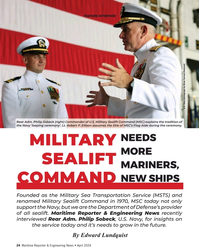 )
April 2024 - Maritime Reporter and Engineering News page: 24
)
April 2024 - Maritime Reporter and Engineering News page: 24FEATURE INTERVIEW U.S. Navy photograph by Brian Suriani/Released Rear Adm. Philip Sobeck (right) Commander of U.S. Military Sealift Command (MSC) explains the tradition of the Navy ‘looping ceremony’. Lt. Robert P. Ellison assumes the title of MSC’s Flag Aide during the ceremony. NEEDS MILITARY MORE
-
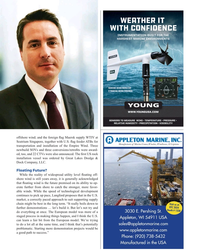 )
April 2024 - Maritime Reporter and Engineering News page: 23
)
April 2024 - Maritime Reporter and Engineering News page: 23and installation of the Empire Wind. Three newbuild SOVs and three conversions/retro? ts were award- ed, too, and 22 CTVs were also announced. The ? rst US rock installation vessel was ordered by Great Lakes Dredge & Dock Company, LLC. Floating Future? While the reality of widespread utility level ? oating
-
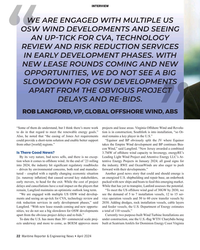 )
April 2024 - Maritime Reporter and Engineering News page: 22
)
April 2024 - Maritime Reporter and Engineering News page: 22INTERVIEW WE ARE ENGAGED WITH MULTIPLE US OSW WIND DEVELOPMENTS AND SEEING AN UP-TICK FOR CVA, TECHNOLOGY REVIEW AND RISK REDUCTION SERVICES IN EARLY DEVELOPMENT PHASES. WITH NEW LEASE ROUNDS COMING AND NEW OPPORTUNITIES, WE DO NOT SEE A BIG SLOWDOWN FOR OSW DEVELOPMENTS APART FROM THE OBVIOUS
